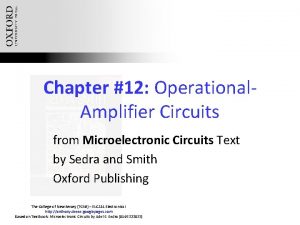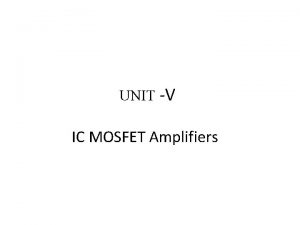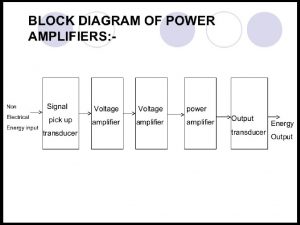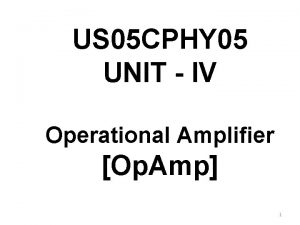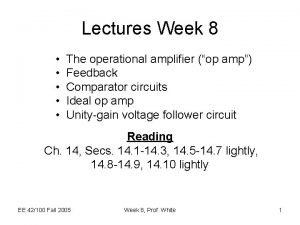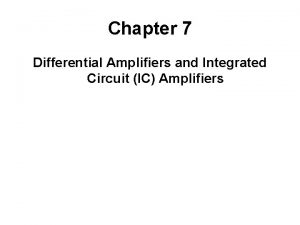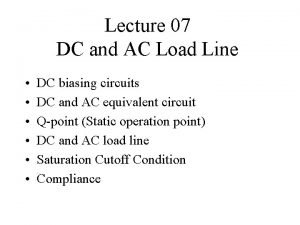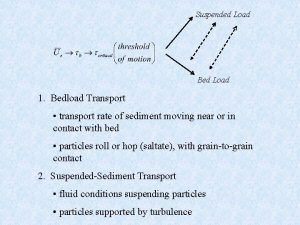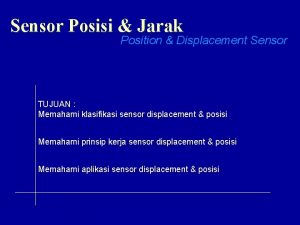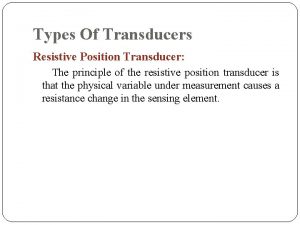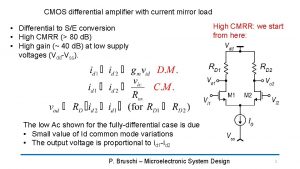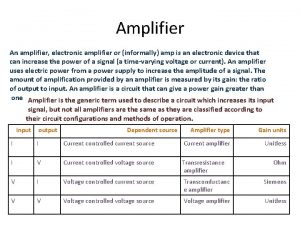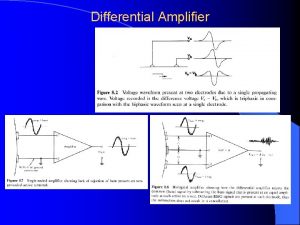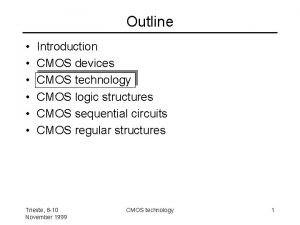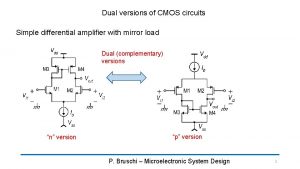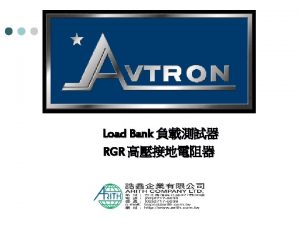CMOS differential amplifier with resistive load limitations 1




























- Slides: 28

CMOS differential amplifier with resistive load: limitations 1. The S/E version has a poor CMRR (large Ac) and large input offset voltage 2. Both the S/E and fully-diff. versions reach low voltage gains at small supply voltage Problem 1: Consider the output voltage in the fullydifferential case with no resistor mismatch: The drain current difference appears: This reduces Ac (ID 1 and ID 2 tend to be equal for only common mode applied) and the output voltage for VD=0 is affected only by matching errors. Solution for a S/E amplifier: produce the current difference (ID 1 -ID 2) and then put it into a single resistor. Problem 2: Do not use a passive component for the resistor P. Bruschi – Microelectronic System Design 1

CMOS differential amplifier with current mirror load Vdd Specifications ID 1+ID 2 ID 1 • We need a S/E output port • High CMRR (> 80 d. B) • High gain (~ 40 d. B) even at low supply voltages (Vdd-Vss). M 3 M 4 Vout ID 1 ID 2 M 1 Vi 1 M 2 Vi 2 I 0 Vss P. Bruschi – Microelectronic System Design 2

Subunits of the amplifier with mirror load I 1 Rout Iocc Vin I 1 I 2 V-to-I I 2 I-to-I P. Bruschi – Microelectronic System Design 3

Operating point : Vid=0 Symmetrical stimulus, but …. The circuit is not symmetrical P. Bruschi – Microelectronic System Design 4

Demonstration of the exact symmetry of the electrical solution for Vid=0 M 1 and M 2 With fixed VGS and VBS, ID is a monotone function of VDS (or |VDS| for a p-MOS. M 3 and M 4 P. Bruschi – Microelectronic System Design 5

Demonstration of the exact symmetry of the electrical solution for Vid=0 From Kirchhoff #2: We want to demonstrate that: Proof by contradiction: Let us suppose: Contradiction P. Bruschi – Microelectronic System Design 6

Demonstration of the exact symmetry of the electrical solution for Vid=0 Repeating the procedure for ID 1<ID 2 we get another contradiction; thus, the only possible solution is: K For Vid=0, the electrical solution is perfectly symmetrical P. Bruschi – Microelectronic System Design 7

Differential mode gain Norton equivalent circuit iric of the output port Circuit for Rout calculation Small-signal equivalent circuit P. Bruschi – Microelectronic System Design 8

Differential mode gain: Rout calculation. Case 1: Case 2: For the superposition theorem: Case 1: Case 2: P. Bruschi – Microelectronic System Design 9

Differential mode gain P. Bruschi – Microelectronic System Design 10

Differential mode gain In strong inversion. Minimum VTE=50 m. V In order to obtain a large differentialmode gain it is necessary to: • Set VTE to a small value • Use long MOSFETs (small l) P. Bruschi – Microelectronic System Design 11

Common mode gain As in the case of differential input voltage, we can try to use the Norton equivalent circuit of the output port. vc vc Is it possible? ? P. Bruschi – Microelectronic System Design 12

Common mode gain The problem occurs when we calculate iocc. Placing a short circuit across the output port, disrupts the symmetry: vc vc P. Bruschi – Microelectronic System Design 13

Common mode gain It is possible to exactly calculate iocc, taking into account the actual id 1/id 2 ratio and id 4/id 3 ratio …. vk vc … but this is a very tedious approach There is a much simpler way: vc Let us remove the short circuit and directly calculate vout. Now , for vid=0, the circuit is symmetric again and, in particular: vk=vout P. Bruschi – Microelectronic System Design 14

Common mode gain vk vc vc for ros=rd (worst case: the tail is the output branch of a simple current mirror) and considering all gm's and rd's equal for simplicity A CMRR of 80 d. B can be easily reached P. Bruschi – Microelectronic System Design 15

Large-signal dc transfer function For VD=0: In strong inversion P. Bruschi – Microelectronic System Design 16

Large-signal dc transfer function Vout variations for small VD variations around the origin gm 1 P. Bruschi – Microelectronic System Design 17

Moving away from the origin, step by step P. Bruschi – Microelectronic System Design 18

Large-signal dc transfer function P. Bruschi – Microelectronic System Design 19

Approximate dc transfer characteristic Vout Vdd Vout(0) -VDMAX VD Vss Example: Ad=100, Vdd-Vss=5 V DVD<50 m. V P. Bruschi – Microelectronic System Design 20

Practically constant and equal to gm 1 Vout Vdd Vout(0) M 4 enters triode region and rd 4 drops down VD M 2 enters triode region and rd 2 drops down Vss P. Bruschi – Microelectronic System Design 21

Minimum output voltage VD in the linear zone is at most a few tens m. V VC varies between VSS and VDD P. Bruschi – Microelectronic System Design 22

Minimum output voltage Weak inversion Strong inversion P. Bruschi – Microelectronic System Design 23

Complete dc transfer characteristic Vdd Vout max(Vout)=Vdd-|VDSAT 4| Vout(0)=Vdd-|VGS 3| Slope=Ad VD min(Vout)=VC -VGS 2+VDSAT 2 VC -VGS 2 Vss P. Bruschi – Microelectronic System Design 24

Minimum supply voltage Vdd-Vss |VDS 3| VDS 1 Vout. S Example: VMIN=100 m. V VDSAT 2=100 m. V |VGS 3|=0. 5 V P. Bruschi – Microelectronic System Design 25

Input common mode range Lower limit As VC is progressively decreased, also VS decreases at the same pace and eventually the voltage across the current source I 0 will get smaller than the minimum value VMIN. From that point on, I 0 will rapidly decrease, turning off the stage. P. Bruschi – Microelectronic System Design 26

Input common mode range Upper limit vk As VC is progressively increased, also VS increases at the same pace. Since Vout=VK =VD 2 = VD 1 is fixed, eventually VDS 1 and VDS 2 will drop below the saturation voltage. P. Bruschi – Microelectronic System Design 27

Input common mode range These overdrive voltages can be made close to zero by design This difference can be >0 because: (Vt 1 is affected by body effect) The input common mode voltage can get even slightly higher than Vdd P. Bruschi – Microelectronic System Design 28
 Cmos differential amplifier
Cmos differential amplifier Active load differential amplifier
Active load differential amplifier Ece 271
Ece 271 Full wave rl load with freewheeling diode
Full wave rl load with freewheeling diode Nmos inverter with resistive load
Nmos inverter with resistive load Cmos amplifier
Cmos amplifier Ic mosfet amplifiers
Ic mosfet amplifiers Difference between voltage and power amplifier
Difference between voltage and power amplifier Ad623 instrumentation amplifier
Ad623 instrumentation amplifier Mosfet differential pair
Mosfet differential pair H165 differential amplifier
H165 differential amplifier Fully differential amplifier circuit
Fully differential amplifier circuit Differential amplifier in biomedical instrumentation
Differential amplifier in biomedical instrumentation Dc analysis of differential amplifier
Dc analysis of differential amplifier Hspice inverter
Hspice inverter The input impedance of a non inverting amplifier is
The input impedance of a non inverting amplifier is Double ended ac voltage gain
Double ended ac voltage gain Educadora differential amplifier
Educadora differential amplifier Emitter coupled differential amplifier
Emitter coupled differential amplifier Large signal analysis of differential amplifier
Large signal analysis of differential amplifier Ac load line
Ac load line Thrust load bearing
Thrust load bearing Red dot
Red dot Bed load and suspended load transport
Bed load and suspended load transport Resistive displacement sensor
Resistive displacement sensor Impedance complex number
Impedance complex number Resistance position transducer
Resistance position transducer Isokinetic exercise definition
Isokinetic exercise definition Pulsus tardus
Pulsus tardus





